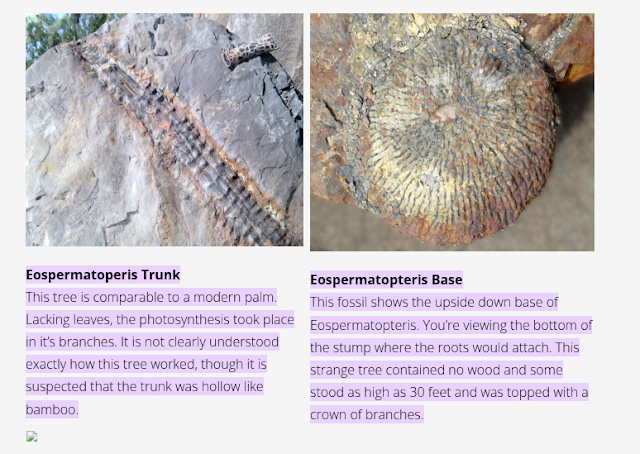"Gilboa Fossil Forest, New York, United States, is a petrified forest and one of the oldest known forests.
Located near the Gilboa Dam in Schoharie County, New York, the region is home to tree trunks from the Devonian period. The fossils, some of the only survivors of their type in the world, are believed to have been from one of the first forests on Earth, and was part of the Earth's afforestation.
- Fossilized Trees: Primarily composed of Eospermatopteris trees, which resembled hollow, bamboo-like plants with fronds.
- Age: Devonian Period, roughly 385 million years ago.
- Significance: The Gilboa forest is believed to be one of the earliest forests on Earth and played a crucial role in the planet's early atmospheric changes.
- Other Fossils: Besides the Eospermatopteris, the area also contains fossils of other early plants like Tetraxylopteris (also called the snake tree) and lycopsids.
- Displays: You can see fossilized stumps and other specimens at the Gilboa Dam site, the New York Power Authority Blenheim-Gilboa Visitor Center, and the New York State Museum. "
"Eospermatopteris was one of the first plants on Earth to have a tree-like form. It resembled a fern - there was no wood on the tree - and grew to be about 30 feet tall.
One Gilboa tree stump specimen includes the underside of a stump with impressions of the roots mixed together with tiny plants called lycopods."
https://www.gilboafossils.org/view-our-fossils/#:~:text=Snake%20Tree%20Crown,with%20a%20crown%20of%20branches.
"The newly uncovered area was preserved in such a way that we were literally able to walk among the trees, noting what kind they were, where they had stood and how big they had grown.”
Scientists are now piecing together a view of this ancient site, dating back about 385 million years ago, which could shed new light on the role of modern-day forests and their impact on climate change.
The recent discovery was made in the same area in Schoharie County where fossils of the Earth’s oldest trees – the Gilboa stumps – were discovered in the 1850s, 1920 and again in 2010 and were brought to the State Museum.
"T he Museum has the world’s largest and best collection of Gilboa fossil tree stumps. For decades scientists did not know what the trees connected to the stumps looked like."
"Picture a hot, tropical landscape near the equator full of shallow seas. Birds and invertebrates don't yet exist. Neither does the Atlantic Ocean. Instead, a mountain range the height of the Andes looms over fragile stretches of trees that resemble palms.
This is what New York state looked like during the Devonian period, roughly 400 million years ago. It was a pivotal moment in time when forests as we now know them first appeared on Earth, radically shifting the planet's climate."
The ancient environments in Cairo and Gilboa were markedly different. Gilboa had water-soaked forests punctuated by catastrophic floods that moved massive amounts of sand.
Cairo saw a quieter environment with both wet and dry periods. A final flood event in Cairo most likely killed the trees in the forests, preserving them like a snapshot in time. Gilboa's trees experienced a similar snapshot event, but in that case, water helped entomb the trees in sand, creating sandstone casts.
"At the beginning of the Devonian, about 420 million years ago, the tallest plants were only several inches tall.
There were no leaves at that point and all the plants were spore bearing. By about 30 million years later, in the middle of the Devonian Period, plants had evolved to tree sized. Gilboa was the first place to make such a major discovery,"
https://www.bbc.com/travel/article/20240229-the-surprising-us-region-thats-home-to-the-worlds-oldest-forests





No comments:
Post a Comment